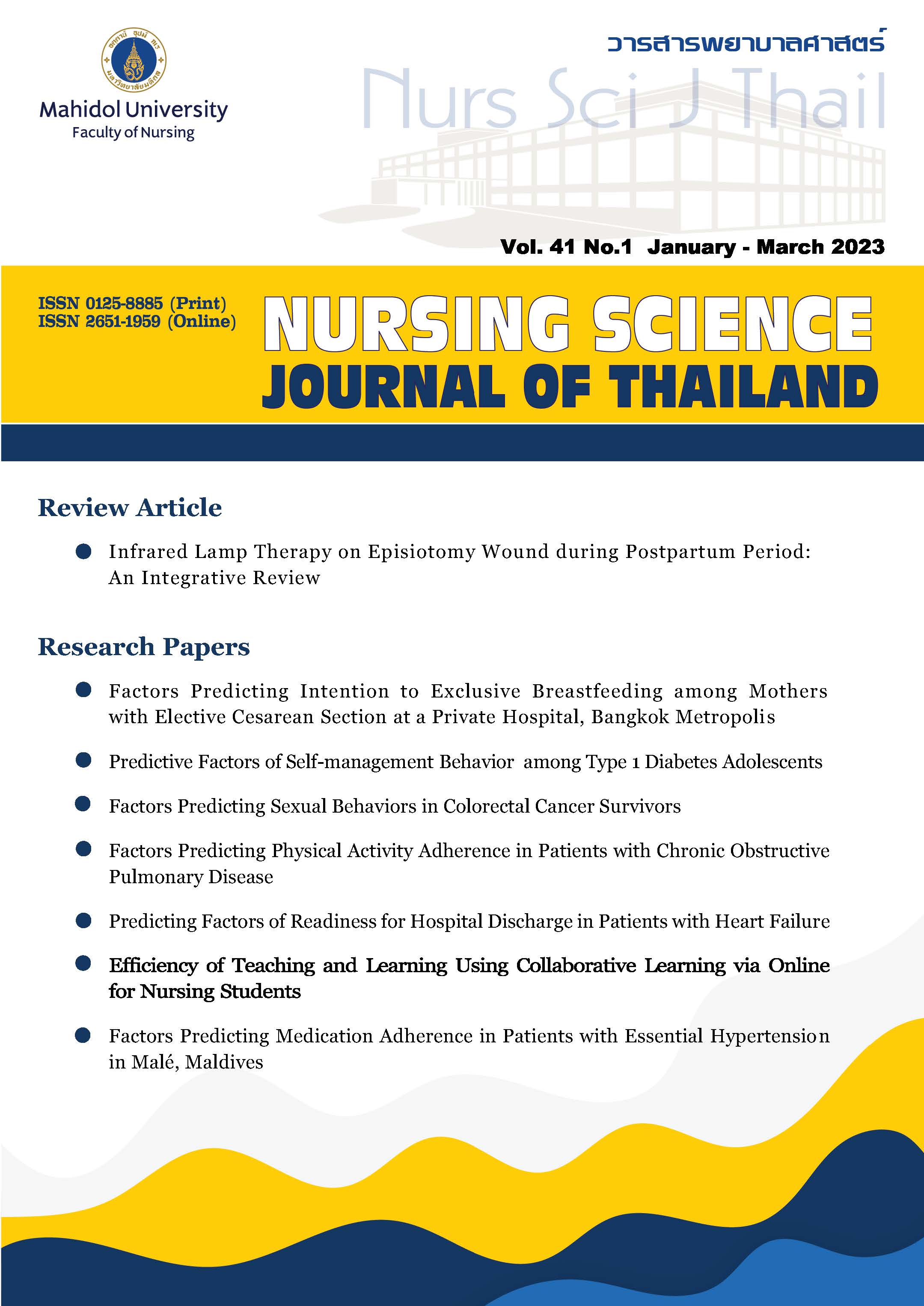Infrared Lamp Therapy on Episiotomy Wound during Postpartum Period An Integrative Review
Main Article Content
Abstract
Purpose: An integrative review of the literature to compare the infrared lamp therapy on episiotomy wound and non-infrared lamp therapy during the postpartum period whether they affected to level of perineal wound pain and wound healing.
Design: The documents were searched from electronic databases including published ScienceDirect, Cochrane, OCLC, HighWire Press, CINAHL, PubMed, Google Scholar and ThaiJO between January 2010 and December 2020. The criterion for selection of the literature followed the PICOT framework.
Research findings: The searching and selection came up with seven-studies; including one experimental research and six quasi-experimental researches.
Conclusion and recommendations: The results of these reviews indicated that, compared to those who did not received infrared lamp therapy group, the mothers who received the therapy showed significantly decreased episiotomy wound pain score within 3 days postpartum, and significant improvement in episiotomy wound healing within 4 days postpartum. The finding suggested that the application of infrared lamp therapy should be encouraged for reducing episiotomy wound pain and wound healing during postpartum.
Article Details

This work is licensed under a Creative Commons Attribution-NonCommercial-NoDerivatives 4.0 International License.
Copyright Notice: Nursing Science Journal of Thailand has exclusive rights to publish and distribute the manuscript and all contents therein. Without the journal’s permission, the dissemination of the manuscript in another journal or online, and the reproduction of the manuscript for non-educational purpose are prohibited.

Disclaimer: The opinion expressed and figures provided in this journal, NSJT, are the sole responsibility of the authors. The editorial board bears no responsibility in this regard.
References
Anusornteerakul S, Muangpin S. Prevention of postpartum perineum infection. Journal of Nursing Science & Health. 2010;33(1):90-8. (in Thai).
Poonperm R. Cold female pad: methods for perineal pain relief after perineorrhaphy. Journal of the Royal Thai Army Nurses. 2014;15(3):32-7. (in Thai).
Somchoe P, Chooha U, Naksukum S. Pain management for perineal pain relief during the postpartum period. Mahasarakham Hospital Journal. 2018;15(3):151-8. (in Thai).
Janmanee T, Yusamran C, Ratinthorn A, Phahuwatanakorn W. Effect of cooling and heat application on perineal inflammation and pain in postpartum mothers. Nursing Science Journal of Thailand. 2014;32(4):25-34. (in Thai).
Songngam V. Electronic infrared heating technique [Internet]. Bangkok: Department of Alternative Energy Development and Efficiency, Ministry of Energy; 2019 [cited 2021 May 9]. Available from http://webkc.dede.go.th/testmax/node/3825. (in Thai).
Kuar P, Prakasam A, Kuar V. A study to evaluate the effectiveness of infrared lamp therapy on healing of episiotomy wound among postnatal mothers admitted in Adesh hospital, Bathinda, Punjab, India. IOSR Journal of Nursing and Health Science. 2019;8(2):61-9. doi: 10.9790/1959-0802016169.
El-lassy RBM, Mohamed Madian AAE. The effect of infrared lamp therapy on episiotomy wound restorative besides pain relief among post-partum women. J Nurs Educ Pract. 2019;9(2):20-30. doi: 10.5430/jnep.v9n2p20.
Sahoo S, Tripathy P. Effect of infrared therapy on episiotomy pain and wound healing among postnatal mothers. Int J Nurs Educ. 2013;5(2):139-42. doi: 10.5958/j.0974-9357.5.2.081.
Sheoran P, Chand S, Kuar S. Comparison of infra red light therapy vs. sitz bath on episiotomy in terms of wound healing among postnatal mothers. Asian Journal of Nursing Education and Research. 2014;4(1):70-5.
Aziz Ismil NIA, Ghattas VN. Effect of infrared lamp therapy versus warm sitz bath on episiotomy wound healing and pain among puerperal mothers. IOSR Journal of Nursing and Health Science. 2019;8(6):44-56. doi: 10.9790/1959-0806094456.
Chandraleka R, Bala Dash M, Chitra F. Effectiveness of sitz bath versus infrared ray therapy on level of episiotomy pain and wound healing among postnatal mothers in selected hospital, Puducherry. Biomed J Sci Tech Res. 2019;21(3):15900-5. doi: 10.26717/BJSTR.2019.21.003605.
Criag J, Smyth RL. The evidence-based practice manual for nurses. 3rd ed. Edinburgh: Churchill Living Stone; 2012. 398 p.
The Joanna Briggs Institute. Critical appraisal tools [Internet]. Adelaide, Australia: The Joanna Briggs Institute; 2020 [cited 2020 Jan 4]. Available from: https://jbi.global/critical-appraisal-tools.
Phokhwang W, Champat C, Ngamwongwiwat B, Wongsawang N, Panawatthanapisuit S. Research quality, assessment, nursing and health. The Journal of Baromarajonani College of Nursing, Nakhonratchasima. 2019;25(2):194-212. (in Thai).
Kummatid A, Markrat M. Using the systematic review to provide a complete summary on a research question in evidence-based practice: a 3-step method. The Southern College Network Journal of Nursing and Public Health. 2016;3(3):246-59. (in Thai).
Chacko JM, Kharde SN, Swamy MK. Effectiveness of infrared lamp on reducing pain and inflammation due to episiotomy wound. Int J Nurs Educ. 2013;5(1):82-5. doi: 10.5958/j.0974-9357.5.1.020.
Shukla A, Bhowmilk SR, Deo S. Infrared lamp therapy on episiotomy pain and wound healing. Indian Journal of Surgical Nursing. 2019;8(3):69-72. doi: 10.21088/ijsn.2277.467X.8319.1.
Kaur P, Sagar N, Deol R, Kuar J. Effectiveness of infra-red therapy upon level of episiotomy pain and wound healing among postnatal mothers. International. J Nurs Educ. 2015;7(2):184-7. doi: 10.5958/0974-9357.2015.00100.2.
Rani E. A study to assess the effectiveness of infrared radiation therapy on pain perception and wound healing among primi postnatal women with episiotomy. International Journal of Advance Research, Ideas and Innovations in Technology. 2018;4(3):419-23.
Nethravathi V, Kshirsagar NS, Kakade SV. Effectiveness of infrared lamp therapy on healing of episiotomy wound among postnatal mothers. Health Sci J. 2015;9(5):3.


